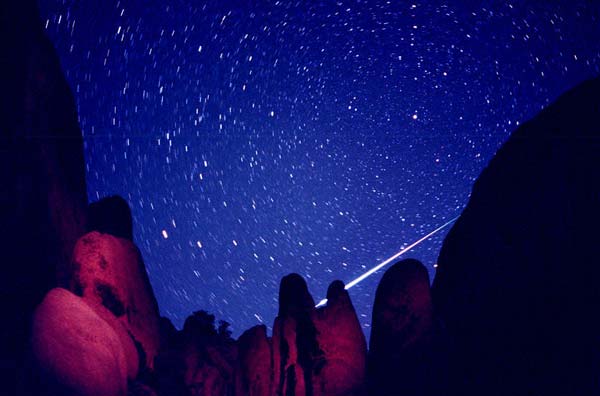Credit & Copyright: Wally Pacholka
Explanation:
Polaris is quite an unusual star. First,
Polaris is the nearest bright star to the
north spin axis of the Earth.
Therefore, as the Earth turns, stars appear to
rotate around Polaris, making it the
North Star.
Since no bright star is near the south spin axis of the Earth,
there is currently no South Star.
Thousands of years ago, Earth's spin axis pointed in a
slightly different direction, and
Vega was the North Star.
Although Polaris is not the brightest star on the sky, it is easily located
because it is nearly aligned with two stars in the cup of the Big Dipper, and is the last star in the handle of the
Little Dipper.
In the above picture,
Polaris is the brightest star on the right,
above the fleeting streak of a
Perseid meteor.
The surface of
Polaris slowly pulsates, causing the star to
change its brightness by a few percent over the course of a few days.
This rare
Cepheid variability
of Polaris is, oddly enough,
itself changing.
1999 2000 2001 2002 2003 2004 2005 2006 2007 2008 2009 2010 2011 2012 2013 2014 2015 2016 2017 2018 2019 2020 2021 2022 2023 2024 2025 |
Yanvar' Fevral' Mart Aprel' Mai Iyun' Iyul' Avgust Sentyabr' Oktyabr' Noyabr' Dekabr' |
NASA Web Site Statements, Warnings, and Disclaimers
NASA Official: Jay Norris. Specific rights apply.
A service of: LHEA at NASA / GSFC
& Michigan Tech. U.
|
Publikacii s klyuchevymi slovami:
cepheid - Earth's rotation - north star - polaris - star - severnyi polyus - Polyus mira - sutochnoe vrashenie - Polyarnaya zvezda - Cefeidy
Publikacii so slovami: cepheid - Earth's rotation - north star - polaris - star - severnyi polyus - Polyus mira - sutochnoe vrashenie - Polyarnaya zvezda - Cefeidy | |
Sm. takzhe:
Vse publikacii na tu zhe temu >> | |
